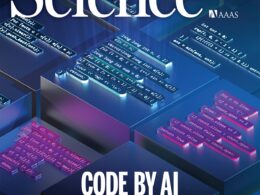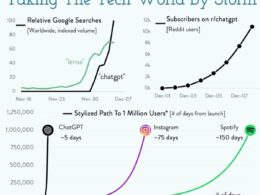the health institute
for continuous health transformation
Joaquim Cardoso MSc
Founder and Chief Researcher, Editor and Advisor
December 15, 2022
This is a republication of the article “What ChatGPT Really Means for the Future of Business”, with the title above.
Source:
FRANÇOIS CANDELON, SYLVAIN DURANTON, LEONID ZHUKOV
DECEMBER 14, 2022
The viral chatbot’s underlying technology will democratize AI and disrupt industries.
OpenAI’s recent release of ChatGPT took the world by storm.
The AI chatbot has sparked an outpouring of curiosity and excitement over its possibilities, as well as concern and debate about its limitations.
But the attention it is garnering shouldn’t obscure a fundamental truth:
Generative AI, the technology underlying ChatGPT, is poised to disrupt nearly every industry in which knowledge from written records, videos, or images can be digitized.
Despite its early-day limitations, ChatGPT’s arrival is an eye-opening moment for leaders of incumbent firms — many of which have struggled to adopt AI solutions at scale.
Generative AI, the technology underlying ChatGPT, is poised to disrupt nearly every industry in which knowledge from written records, videos, or images can be digitized.
Despite its early-day limitations, ChatGPT’s arrival is an eye-opening moment for leaders of incumbent firms — many of which have struggled to adopt AI solutions at scale.

The near term: democratizing AI
Generative AI refers to a computational paradigm in which algorithms generate human-level content.
Generative AI refers to a computational paradigm in which algorithms generate human-level content.
Over the next one to three years, generative algorithms will democratize AI access through two key levers:
1.Providing a natural language interface.
Generative AI enables users to easily develop and interact with AI systems through natural human language in a conversational manner, with the system also providing natural language feedback.
This reduces the need for specialized skills such as coding, enabling more people to interact with and use AI.
This reduces the need for specialized skills such as coding, enabling more people to interact with and use AI.
2.Lowering barriers to entry.
AI has traditionally required three ingredients for successful use:
- high quality data to train algorithms,
- talented engineers to develop algorithms, and
- hardware with fast computation to train algorithms.
Generative AI shifts the burden of supplying these ingredients from the end consumer to a centralized player by using “foundation models.”
AI has traditionally required three ingredients for successful use: (1) high quality data to train algorithms, (2) talented engineers to develop algorithms, and (3) hardware with fast computation to train algorithms.
Generative AI shifts the burden of supplying these ingredients from the end consumer to a centralized player by using “foundation models.”
These foundation models are pre-trained by firms like OpenAI or Stability AI and are available off the shelf, and by Hugging Face, which fosters an open-source community.
The end user can then customize the models through a process called fine-tuning to solve specific tasks using very small amounts of data (ranging from a handful of examples to less than 10% of the size of the pre-training dataset).
Because pre-training centralizes the computing, data, and talent resources and distributes the costs among many end-users, it effectively lowers the barriers to entry.
Because pre-training centralizes the computing, data, and talent resources and distributes the costs among many end-users, it effectively lowers the barriers to entry.
With Generative AI, existing applications are significantly cheaper and more effective to use.
For example, incorporating real-time defect recognition into the manufacturing process can save companies millions in costs down the line.
For example, incorporating real-time defect recognition into the manufacturing process can save companies millions in costs down the line.
With Generative AI, companies will soon be able to download an off-the-shelf image recognition solution, fine-tune it with just a few hundred images of defects, and then be ready to deploy the solution.
A process that previously took months and hundreds of thousands of dollars will be done quickly and at a fraction of the cost.
A process that previously took months and hundreds of thousands of dollars will be done quickly and at a fraction of the cost.

The medium term: driving innovation
Meanwhile, in the next three to five years, generative algorithms will turbocharge industries with new capabilities through “transfer learning” — a key feature of foundation models.
Transfer learning enables models to take the learnings from one task and apply it to another, and to connect seemingly distinct concepts.
For example, ChatGPT can write a poem about quantum mechanics in the style of Robert Frost by connecting “poem,” “quantum mechanics,” and “Robert Frost.”
In biopharma, this technology can help scientists generate candidate molecules for treating novel diseases and shorten R&D cycle times.
Engineers could create tailor-made materials with specific properties, such as tensile strength and flexibility, to suit novel use cases.
Software developers could code full applications from scratch by simply instructing the AI, taking the concept of “no-code/low code” to another level.
With research already underway in these and other avenues and new applications being introduced almost weekly, rapid change is coming to many industries — which leaders in incumbent firms need to prepare for.
To stay competitive in the marketplace, they should begin to utilize Generative AI in their organizations.
They can start by embracing the democratizing power of Generative AI for use cases within their businesses that have historically not had enough data, talent, or resources for an AI solution.
They can start by embracing the democratizing power of Generative AI for use cases within their businesses that have historically not had enough data, talent, or resources for an AI solution.
The opportunity is within reach: Several open-source implementations of foundation models (for example, Hugging Face and Stability AI) are already downloadable and fine-tunable.
Perhaps most important, leaders must reimagine the scope of what is possible with Generative AI.
They need to see beyond today’s viral moment, and the imperfections of ChatGPT in its nascent form — and instead envision the potential for its underlying technology to disrupt and transform.
Perhaps most important, leaders must reimagine the scope of what is possible with Generative AI.
They need to see beyond today’s viral moment, and the imperfections of ChatGPT in its nascent form — and instead envision the potential for its underlying technology to disrupt and transform.
Originally published at https://bcghendersoninstitute.com on December 14, 2022.
Names mentioned
OpenAI, Hugging Face, stability AI












